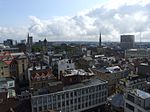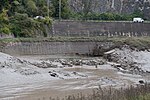Bristol Bridges Walk
BridgesEngvarB from October 2013Footpaths in BristolGraph theoryMathematical problems ... and 1 more
Mathematical puzzles
The Bristol Bridges Walk is a circular hiking route that is linked to the Königsberg bridge problem, a mathematical puzzle, which laid the foundation for graph theory, the mathematical study of networks. The Bristol Bridges Walk presents a solution of the puzzle for the city of Bristol. Its route leads the walker through different quarters of the city, the Avon Gorge and Leigh Woods. Along the way it crosses 45 bridges including Clifton Suspension Bridge, Bristol Bridge, and Avonmouth Bridge. The walk featured in various charity fundraisers of which the Bristol Giving Day 2019 is perhaps the most notable.
Excerpt from the Wikipedia article Bristol Bridges Walk (License: CC BY-SA 3.0, Authors).Bristol Bridges Walk
Bridge Street, Bristol Broadmead
Geographical coordinates (GPS) Address Nearby Places Show on map
Geographical coordinates (GPS)
| Latitude | Longitude |
|---|---|
| N 51.454336 ° | E -2.591579 ° |
Address
Bridge Street
BS1 2AW Bristol, Broadmead
England, United Kingdom
Open on Google Maps








